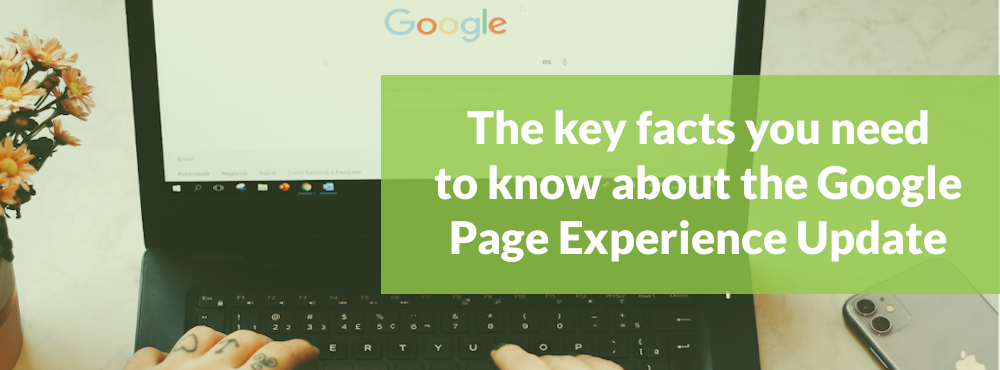There’s a new Google algorithm about to be rolled out – although we’ve known about this one for about a year now. That said, brands would be forgiven for having other priorities on their mind over the last twelve months!
Expected this month (May 2021), the release is being called the Google Page Experience update – perhaps not the most creative title, but it’s promising to do what it says on the tin: add page experience to the factors that decide the ranking of pages within Google search engine results pages. If the page experience is positive (and you’re ticking lots of other SEO boxes too) then your pages may see an uptick in rankings – and hopefully organic traffic.
As with all Google updates, there are a lot of ‘ifs’ and ‘buts’ – you can never be too sure how the update will manifest itself in reality, or how it’ll impact your organic search engine rankings and organic traffic. That said, it’s worth keeping an eye on updates Google is planning, or is suspected of, releasing – it’s all valuable intel that could help you optimise your website. So, let’s take a bit more of an in depth look at the Page Experience Update…
What do we mean by page experience?
If a page is slow to load, bombards you with pop-ups and has shifting layouts or lacks responsiveness on mobile, you might say that the page experience has been poor. You couldn’t find what you were looking for easily or had to wait to get it. We’ve all been on websites where the experience makes us give up quickly and bounce off the page.
There are many factors that impact page experience, either negatively or positively – and Google already uses some of these to contribute towards rankings within its results pages. For example, the mobile-friendliness of a page, whether it is HTTP or HTTPS, and a page’s loading speed are already used by Google to contribute towards rankings.
Yet, the Page Experience update takes this a step further and incorporates some new metrics that will also be used by Google – and in turn can be used by marketers to monitor their page experience. These are: LCP (Largest Contentful Paint), CLS (Cumulative Layout Shift), and FID (First Input Delay).
They sound quite complicated but they essentially relate to:
- The time it takes for the main content of the page to have most likely loaded.
- The time it takes from when a user first interacts with a page, to the time when the browser begins processing that interaction.
- Whether there are unexpected (and irritating!) movements of the content on a page. For example, if you visit a web page and try to interact with a call-to-action or read particular content, and then something else loads on the page and the layout all shifts – moving what you were interacting with.
There’s more information about what LCP, CLS and FID are and what they mean for page experience in this article by Search Engine Land.
Is there still time to make page experience improvements?
Let’s start by saying – there is always time to improve your website to give users a positive experience when they hit a page! Regardless of Google’s algorithm update schedule, creating a positive experience for your website users should always be pretty high on your list of digital marketing priorities.
And it’s not just the fact that page experience contributes to Google rankings that should be motivating you to take note. Creating a positive on-page experience for users is vital if you want to present your brand well and help users to seamlessly consume your content and explore your offering. And let’s face it – who doesn’t want that?
A great example of why user experience matters is by looking at page loading speeds. Previous research by Google suggested that as page load time goes from one second to 10 seconds, the probability of a mobile site visitor bouncing increases by 123%. A slow website turns off users – and those users could have turned into customers.
The Page Experience Update also looks like it will see the testing of a “visual indicator that highlights pages in search results that have great page experience”. In essence that means people searching in Google will see an icon (likely to be in a similar vein to the lightning bolt used to signify AMP articles) that indicates a good page experience on that website (as determined, most likely, by LCP, CLS and FID). We’ll have to wait and see how this manifests itself, but having a good page experience icon next to your page in search engine results sounds like the type of thing that will increase click-throughs, and thus organic traffic.
How can you tell if your website needs page experience improvements and, if so, what improvements should be made?
Hopefully I’ve convinced you to add page experience priorities list, if it isn’t already. So now to the question – how can you tell if your page experience is positive or not?
There are lots of tools out there that can help you to measure factors that contribute towards a good page experience – but perhaps the most relevant to this particular Google update is the Search Console Core Vitals Web Report. This report is focussed on measuring LCP, CLS and FID – great news for a quick way to check the health status of your website in light of the algorithm update! You can learn how to use this report here.
But it is still worth looking at your website more broadly to see if it does offer a positive experience for users – as there are so many factors that come into play here. It’s no small task, but in our opinion it’s worthwhile auditing your website on a regular basis – and it’s probably worth doing now if you think your website might not be ticking the page experience boxes. Focus on factors such as page load speeds, responsiveness, UX, mobile usability, and security, as well as analysing your content and website design.
Whether you don’t have the time to conduct such an audit, you have identified issues via the Core Vitals Web Report or you simply aren’t sure where to start with creating a positive user experience, it’s worth getting in touch with your website developer or a digital marketing specialist.
What can you do to improve your website’s page experience?
As mentioned before, page experience (and all that comes within that category) is only a fraction of the contributing factors towards Google rankings. So, as with any Google update, don’t get too hung up on the specifics – they’re good to know, and vital for digital marketers like us to be aware of, but you must look holistically at your website to see if it’s working for you – and your website users.
That’s why so many digital marketing thinktanks are currently reviewing the Page Experience Update and the details surrounding it, but they’re also still reinforcing the fundamentals of a good website. And what are those fundamentals? Good design, good accessibility and, vitally, good content. If you focus on achieving these three things, you’ll likely have a website that delivers a good page experience.
Ultimately, in our view, when it comes to page experience content is still king. Good content that delivers what the user is searching for, offers clear calls-to-action and provides an engaging experience is vital for your SEO – if you have good content, and then go on to tick the boxes for updates such as the Page Experience Update, that’s when you’ll most likely see improvements in search engine rankings. Neglect the content and you’ll be fighting an uphill battle.
All-in-all, the Google Page Experience Update is an important one to be aware of – but it shouldn’t be the only reason why you’re focussing in on user experience. Your website will always perform best with great content, regular auditing and an ongoing SEO strategy. Improving user experience – and in turn page experience – can be a long-game, involving multiple stakeholders to improve multiple facets of your website. But in our view, it’s well worth the investment.





